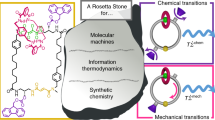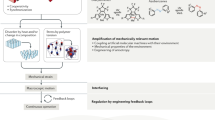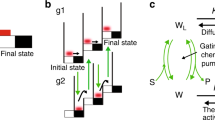Abstract
Motor proteins and other biological machines are highly efficient at converting energy into directed motion and driving chemical systems away from thermodynamic equilibrium1. But even though these biological structures have inspired the design of many molecules that mimic aspects of their behaviour2,3,4,5,6,7,8,9,10,11,12,13,14,15, artificial nanomachine systems operate almost exclusively by moving towards thermodynamic equilibrium, not away from it. Here we show that information about the location of a macrocycle in a rotaxane—a molecular ring threaded onto a molecular axle—can be used, on the input of light energy, to alter the kinetics of the shuttling of the macrocycle between two compartments on the axle. For an ensemble of such molecular machines, the macrocycle distribution is directionally driven away from its equilibrium value without ever changing the relative binding affinities of the ring for the different parts of the axle. The selective transport of particles between two compartments by brownian motion in this way bears similarities to the hypothetical task performed without an energy input by a ‘demon’ in Maxwell’s famous thought experiment16,17,18,19. Our observations demonstrate that synthetic molecular machines can operate by an information ratchet mechanism20,21,22, in which knowledge of a particle’s position is used to control its transport away from equilibrium.
This is a preview of subscription content, access via your institution
Access options
Subscribe to this journal
Receive 51 print issues and online access
$199.00 per year
only $3.90 per issue
Buy this article
- Purchase on Springer Link
- Instant access to full article PDF
Prices may be subject to local taxes which are calculated during checkout




Similar content being viewed by others
References
Schliwa, M. (ed.) Molecular Motors (Wiley-VCH, Weinheim, 2003)
Bissell, R. A., Córdova, E., Kaifer, A. E. & Stoddart, J. F. A chemically and electrochemically switchable molecular shuttle. Nature 369, 133–137 (1994)
Kelly, T. R., De Silva, H. & Silva, R. A. Unidirectional rotary motion in a molecular system. Nature 401, 150–152 (1999)
Koumura, N., Zijlstra, R. W. J., van Delden, R. A., Harada, N. & Feringa, B. L. Light-driven monodirectional molecular rotor. Nature 401, 152–155 (1999)
Brouwer, A. M. et al. Photoinduction of fast, reversible translational motion in a hydrogen-bonded molecular shuttle. Science 291, 2124–2128 (2001)
Leigh, D. A., Wong, J. K. Y., Dehez, F. & Zerbetto, F. Unidirectional rotation in a mechanically interlocked molecular rotor. Nature 424, 174–179 (2003)
Thordarson, P., Bijsterveld, E. J. A., Rowan, A. E. & Nolte, R. J. M. Epoxidation of polybutadiene by a topologically linked catalyst. Nature 424, 915–918 (2003)
Badjić, J. D., Balzani, V., Credi, A., Silvi, S. & Stoddart, J. F. A molecular elevator. Science 303, 1845–1849 (2004)
Hernández, J. V., Kay, E. R. & Leigh, D. A. A reversible synthetic rotary molecular motor. Science 306, 1532–1537 (2004)
Fletcher, S. P., Dumur, F., Pollard, M. M. & Feringa, B. L. A reversible, unidirectional molecular rotary motor driven by chemical energy. Science 310, 80–82 (2005)
Liu, Y. et al. Linear artificial molecular muscles. J. Am. Chem. Soc. 127, 9745–9759 (2005)
Berná, J. et al. Macroscopic transport by synthetic molecular machines. Nature Mater. 4, 704–710 (2005)
Shirai, Y., Osgood, A. J., Zhao, Y., Kelly, K. F. & Tour, J. M. Directional control in thermally driven single-molecule nanocars. Nano Lett. 5, 2330–2334 (2005)
Eelkema, R. et al. Molecular machines: Nanomotor rotates microscale objects. Nature 440, 163 (2006)
Muraoka, T., Kinbara, K. & Aida, T. Mechanical twisting of a guest by a photoresponsive host. Nature 440, 512–515 (2006)
Maxwell, J. C. Letter to P. G. Tait, 11 December 1867. Reproduced in The Scientific Letters and Papers of James Clerk Maxwell Vol. II, 1862–1873 (ed. Harman, P. M.) 331–332 (Cambridge Univ. Press, Cambridge, UK, 1995)
Maxwell, J. C. Theory of Heat Ch. 22 (Longmans, Green and Co., London, 1871)
Maxwell, J. C. Letter to P. G. Tait, circa. 1875. Reproduced in The Scientific Letters and Papers of James Clerk Maxwell Vol. III, 1874–1879 (ed. Harman, P. M.) 185–187 (Cambridge Univ. Press, Cambridge, UK, 2002)
Leff, H. S. & Rex, A. F. Maxwell’s Demon 2. Entropy, Classical and Quantum Information, Computing (Institute of Physics Publishing, Bristol, 2003)
Astumian, R. D. & Derényi, I. Fluctuation driven transport and models of molecular motors and pumps. Eur. Biophys. J. 27, 474–489 (1998)
Parmeggiani, A., Jülicher, F., Ajdari, A. & Prost, J. Energy transduction of isothermal ratchets: Generic aspects and specific examples close to and far from equilibrium. Phys. Rev. E 60, 2127–2140 (1999)
Parrondo, J. M. R. & De Cisneros, B. J. Energetics of Brownian motors: A review. Appl. Phys. A 75, 179–191 (2002)
Tokunaga, Y., Akasaka, K., Hisada, K., Shimomura, Y. & Kakuchi, S. A rotaxane synthesis based on stilbene photoisomerization. A photoswitchable catch and release process. Chem. Commun. 2250–2251 (2003)
Kolchinski, A. G., Busch, D. H. & Alcock, N. W. Gaining control over molecular threading: benefits of second coordination sites and aqueous–organic interfaces in rotaxane synthesis. J. Chem. Soc. Chem. Commun. 1289–1291 (1995)
Ashton, P. R. et al. Dialkylammonium ion/crown ether complexes: the forerunners of a new family of interlocked molecules. Angew. Chem. Int. Edn Engl. 34, 1865–1869 (1995)
Hammond, G. S. et al. Mechanisms of photochemical reactions in solution. XXII. Photochemical cis–trans isomerization. J. Am. Chem. Soc. 86, 3197–3217 (1964)
Bennett, C. H. The thermodynamics of computation – a review. Int. J. Theor. Phys. 21, 905–940 (1982)
Chatterjee, M. N., Kay, E. R. & Leigh, D. A. Beyond switches: ratcheting a particle energetically uphill with a compartmentalized molecular machine. J. Am. Chem. Soc. 128, 4058–4073 (2006)
Kay, E. R. & Leigh, D. A. Lighting up nanomachines. Nature 440, 286–287 (2006)
Reimann, P. Brownian motors: Noisy transport far from equilibrium. Phys. Rep. 361, 57–265 (2002)
Acknowledgements
We thank P. J. Camp and his research group for the free energy calculation, and the EPSRC, the EU project Hy3M and the Carnegie Trust for financial support. D.A.L. is an EPSRC Senior Research Fellow and holds a Royal Society-Wolfson research merit award.
Author Contributions V.S., C.-F.L. and E.R.K. contributed equally to this work.
Author information
Authors and Affiliations
Corresponding author
Ethics declarations
Competing interests
Reprints and permissions information is available at www.nature.com/reprints. The authors declare no competing financial interests.
Supplementary information
Supplementary Information
This file contains Supplementary Notes and Supplementary Figures S1-S7 with legends and additional references. The file contains details of synthetic procedures for the preparation of thread and rotaxane molecules, the results from a repeat run of the photochemical experiments carried out on rotaxane 1, and a Supplementary Figure containing the 1H NMR spectra relevant to the experiment on control rotaxane 2 (reported in Fig. 4 of the main text). Also included are the results of photochemical experiments carried on model compounds and a discussion of these in relation to the kinetic mechanism of operation of the molecular machine. Explanatory notes are also provided in relation to the effect of stilbene isomerization on the macrocycle binding affinities for the ammonium sites and the calculation of the extent to which the molecular machine is moved away from equilibrium. (PDF 1674 kb)
Rights and permissions
About this article
Cite this article
Serreli, V., Lee, CF., Kay, E. et al. A molecular information ratchet. Nature 445, 523–527 (2007). https://doi.org/10.1038/nature05452
Received:
Accepted:
Issue Date:
DOI: https://doi.org/10.1038/nature05452
This article is cited by
-
A supramolecular cucurbit[8]uril-based rotaxane chemosensor for the optical tryptophan detection in human serum and urine
Nature Communications (2023)
-
Ratcheting synthesis
Nature Reviews Chemistry (2023)
-
ABC transporters are billion-year-old Maxwell Demons
Communications Physics (2023)
-
Quantum Heat Engine with Level Degeneracy for Oscillator-shaped Potential Well
International Journal of Theoretical Physics (2023)
-
Chemically controlled self-assembly behaviors of dibenzo-24-crown-8 bearing ammonium salt moiety
Journal of Inclusion Phenomena and Macrocyclic Chemistry (2023)
Comments
By submitting a comment you agree to abide by our Terms and Community Guidelines. If you find something abusive or that does not comply with our terms or guidelines please flag it as inappropriate.



